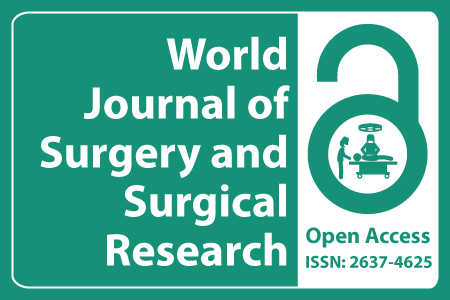
Journal Basic Info
- Impact Factor: 1.989**
- H-Index: 6
- ISSN: 2637-4625
- DOI: 10.25107/2637-4625
Major Scope
- Minimal Invasive Surgery
- Surgery & Surgical Research
- Hand Surgery
- Ophthalmology
- Breast Surgery
- Robotic Surgery
- Oral & Maxillofacial Surgery
- Podiatric Surgery
Abstract
Citation: World J Surg Surg Res. 2018;1(1):1064.DOI: 10.25107/2637-4625.1064
Hiatal Hernioplasty with a Novel Composite Mesh Design: Results of a Multicenter Study after Two- Years Follow-up
Delgado Fernando, Aguiló Javier, Asencio Francisco, Primo Vicent, Gomez-Abril Segundo, Saborit Rosa and Carvajal-López Fernando
Department of Surgery, Hospital Universitario Doctor Peset, Spain
Department of Surgery, Hospital Público Lluis Alcanyis De Xátiva, Spain
Department of Surgery, Hospital Arnau de Vilanova, Spain
Department of Surgery, Hospital de Dénia-MarinaSalud, Spain
*Correspondance to: Fernando Carvajal López
PDF Full Text Research Article | Open Access
Abstract:
Background: Surgical treatment of paraesophageal hiatal hernia is still controversial, particularly in aspects related to surgical technique, being the main problem the high recurrence rate, between 20% and 30%.
Methods: The aim of this study is to describe the surgical technique and results of laparoscopic repair of paraesophageal hernia using a new composite silicone/polypropylene mesh. This is a retrospective study of 61 patients who underwent laparoscopic repair of symptomatic large (6 cm or more in diameter) hiatal hernias in three public hospitals of the Valencia Community (Spain). The study analyzes postoperative mesh-related morbidity, functional outcomes and recurrence rate.
Results: There were two conversions due to technical difficulties. The mean hospital stay was 3.2 days. Mean follow-up was 26 months. A recurrence rate of 11.7% was recorded. Complications, reoperations and quality of life are analyzed.
Conclusion: This newly designed prosthetic mesh offers easy laparoscopic implantation with acceptable recurrence and complications. Additional studies are needed to determine the most appropriate material and shape to cover hiatal defects.
Keywords:
Paraesophageal hernia; Hiatoplasty; Hiatal hernioplasty; Mesh; Laparoscopic repair
Cite the Article:
Fernando D, Javier A, Francisco A, Vicent P, Segundo G-A, Rosa S, et al. Hiatal Hernioplasty with a Novel Composite Mesh Design: Results of a Multicenter Study after Two- Years Follow-up. World J Surg Surgical Res. 2018; 1: 1064.













